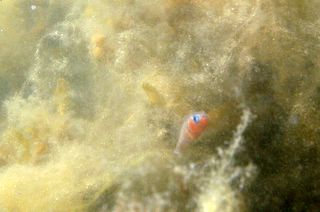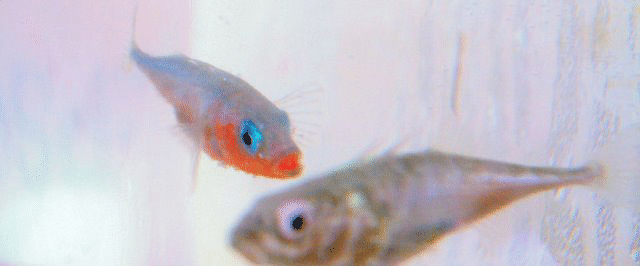Eutrophication of the Baltic Sea- consequences for stickleback populations
We investigate the effects of the eutrophication of the Baltic Sea on the reproductive behaviour of a common littoral fish, the three-spined stickleback Gasterosteus aculeatus, and how this in turn influences evolutionary processes.
Sexual selection is one of the main forces of evolution and gives rise to the evolution of characters that increase mating and fertilisation success. It is opposed by viability selection and its intensity varies in time and space, depending on environmental heterogeneity. While equilibrium between sexual and viability selection may be achieved in one environment, changes in conditions can alter the balance between sexual and viability selection and influence population dynamics.
 Human-induced eutrophication is a serious environmental problem in many aquatic systems, with notorious effects in the Baltic Sea. It alters habitat structure by increasing the growth of filamentous algae at the expense of slower growing macro algae, and increases water turbidity by promoting the growth of phytoplankton. Such ecological changes are expected to alter evolutionary processes, which in turn may induce further ecological changes.
Human-induced eutrophication is a serious environmental problem in many aquatic systems, with notorious effects in the Baltic Sea. It alters habitat structure by increasing the growth of filamentous algae at the expense of slower growing macro algae, and increases water turbidity by promoting the growth of phytoplankton. Such ecological changes are expected to alter evolutionary processes, which in turn may induce further ecological changes.
Our results show that eutrophication relaxes sexual selection on reproductive traits. Interestingly, this increases the cost of sexually selected traits and, apparently, relaxes the good genes process. Thus, the response of these fish to eutrophication appears maladaptive at the individual level. However, the reproductive output of the populations increases under eutrophication. A relaxation of sexual selection could therefore be compensated by strengthened natural selection at later life-history stages, such as the juvenile stage. This could enhance selection for populations adapted to eutrophied conditions and ensure the success of the stickleback in the changing environment.
The results also show that sticklebacks express a high degree of phenotypic flexibility and that populations separated by only a few kilometres exhibit local adaptation. This suggests that sticklebacks have the potential to relatively quickly adapt to different environmental conditions. High plasticity could be one explanation for why sticklebacks have been able to rapidly adapt to a range of different freshwater conditionsfrom their marine origin. Plasticity may initially have allowed the population to survive and reproduce in a new environment and thereby given the population time to accrue genetic changes and genetically adapt to the new conditions. This plasticity could now help the species to adapt to anthropogenic disturbances.
